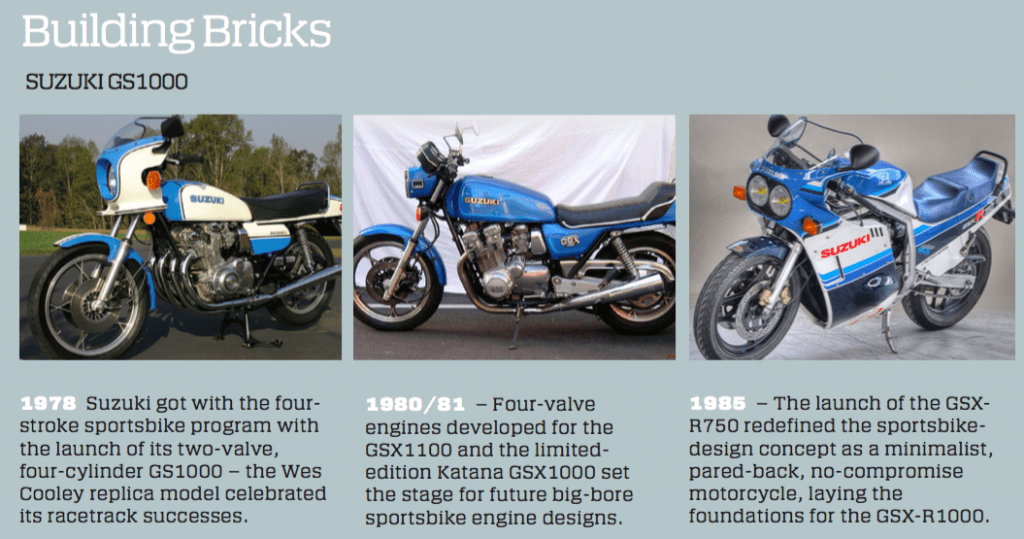With Yamaha’s YZF-R1 sitting pretty as top dog in the performance-bike stakes as the new millennium dawned, Suzuki’s reputation for super-competitive machines was under serious challenge. While its GSX-R750, the original ‘racer with lights’, had been a game-changer, there was no prospect at this point of its supersport hottie competing with Team Blue’s potent litre bike. Compounding Suzuki’s dilemma was the recent phasing out of its GSX-R1100 that had lost its performance mojo toward the end. Although Suzuki’s response was a little slow in coming, when the GSX-R1000 was finally launched in 2001 it thrust the Hamamatsu factory back into its leader-of-the-pack position.
In this review we’re looking at the first and second generation GSX-R1000s –the K1 and K2 models (2001-2003) and the revised K3 and K4 models (2003-2005). While the much-revised third generation K5 model that followed was a quicker bike on a racetrack, it was noticeably more compact and consequently less accommodating for larger riders.
The GSX-R’s 988cc, 16-valve, fuel-injected, in-line, four-cylinder engine and six-speed gearbox are carried in an aluminium beam frame that rides on fully adjustable suspension – 43mm Kayaba inverted forks and rear monoshock with link. In the braking department the K1 and K2 models feature six-pot calipers gripping 320mm discs; K3 and K4 have lighter radial-mount four-pot calipers and 300mm discs.
Astride a Gixxer you’re in charge of around 168-170kg (dry weight) of sleek sportsbike with 120kW or more on tap. You view the world over a low screen from a minimalist 830mm-high seat, monitoring its performance via an analogue tacho and digital speedo. The sleek fairing and screen provide decent protection form the elements. Surprisingly for a ‘racer-crouch’ sportsbike the ergonomics and seat provide reasonable comfort for a broad range of rider shapes and sizes.
Once you’re underway the clutch action is smooth and throttle response is surprisingly linear – almost docile in traffic before surging into a robust midrange on the way to a truly fearsome top end. Gearshift action is pure Suzuki – accurate and smooth.
Braking performance of all models is well up to the task of dealing with the performance.
The ride is firm and the handling is excellent, giving the stable, neutral-steering Gixxer the ability to carve through a sequence of bends with scalpel-like precision, road surface permitting. Throttle wheelies are par for the course in lower gears – every crest on your favourite fast backroad is a launch ramp. The marginal gains in handling and performance of the K3 and K4 models, resulting from subtle revisions to chassis, engine and electronics, will be barely noticeable 99 per cent of the time. You can pick the later bikes by their black painted frames, vertical headlight configuration and full titanium exhausts.
Even lined up against the latest crop of superbikes these early Gixxers are seriously fast – as an indication they’ll blast along a drag strip in the low 10s.
Bear in mind that these potent pre-ABS and pre-traction-control machines demand full concentration and practiced rider skills if they’re ridden anywhere near their limits.
The GSX-R’s not unreasonable thirst delivers a safe touring range of better than 230km from the 18-litre tank.
In summarising, let’s be clear that a Suzuki GSX-R is a furiously fast, bare-knuckles superbike with ‘racer-crouch’ ergonomics and marginal pillion comfort. It can have quite an appetite for tyres, chains and sprockets when ridden hard. Sure you can commute on one – the engine is remarkably tractable in traffic. But that’s not its real role. It’s the ideal sunny-Sunday bike for spirited backroads action and occasional trackdays. It’s no hack mount – it’s a pared-back thoroughbred, a bike that showcases engineering excellence, making it a huge ‘bang for bucks’ proposition at under $8000.

PRICE GUIDE
New Price
$17,990 (2001) $18,690 (2005)
WHAT TO LOOK FOR
The GSX-R1000 is pretty much bulletproof mechanically, enabling well-maintained examples to be hale and hearty with big kilometres on the clock.
Check for any second-gear issues and notchy steering-head bearings from too many wheelies. Drilled drain plugs and caliper bolts and rim-edge damage witnessing frequent tyre changes help to identify ex-trackday or racebikes. Check fairings for cracking around fasteners.
Adjust your offer to cover almost worn-out consumables like chain, sprockets, brake pads and brake rotors.
A gem would be a damage-free, low k’s example with a good service record.
SERVICE HISTORY
Basic servicing of a GSX-R is reasonably straightforward. Removal of the RH fairing gives decent access for oil changes. Access to the oil filter is trickier, but patience wins every time.
Minor services are required every 6000km, with sparkplug changes every 12,000km and valve clearances every 24,000km.
While DIY owners can handle routine servicing, the complexity of the 12,000km and 24,000km services is best left to qualified technicians with access to the right equipment

WORDS ROB BLACKBOURN PHOTOGRAPHY AMCN ARCHIVES











